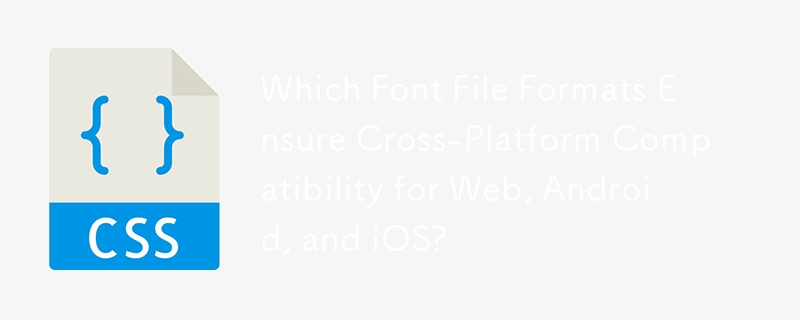Home >Web Front-end >CSS Tutorial >Which Font File Formats Ensure Cross-Platform Compatibility for Web, Android, and iOS?
Which Font File Formats Ensure Cross-Platform Compatibility for Web, Android, and iOS?
- Susan SarandonOriginal
- 2024-11-11 02:36:021172browse

Web Font Compatibility in Modern Browsers, Android, and iOS
With the evolution of web technologies, the need for universally compatible font files has become paramount. This article delves into the specific font file formats required to ensure seamless integration across modern browsers, Android, and iOS devices.
Font File Formats for Cross-Platform Compatibility
In the quest for cross-platform font compatibility, the following file formats are recommended:
- WOFF2 (Web Open Font Format 2): The WOFF2 format offers significant improvements over its predecessor, WOFF, providing both lossless compression and enhanced performance. It is widely supported by modern browsers, Android, and iOS devices.
OBSOLETE FORMATS
- EOT (Embedded OpenType): EOT is now considered obsolete with the advent of WOFF2. It's no longer necessary to include EOT files, as WOFF2 provides a superior solution.
- SVG (Scalable Vector Graphics): SVG font support in browsers has been abandoned due to its inherent limitations and bloated file sizes. It's recommended to leverage modern web font formats instead.
- Plain TTF/OTF (TrueType Font/OpenType Font): These formats are not suitable for web use as they contain unnecessary data for web applications. It's more efficient to use optimized web font formats specifically designed for online environments.
Simplification for Optimal Performance
WOFF2 not only provides superior compression but also streamlines the OpenType font specification, making it suitable for web deployment. It adheres to the principles of web-specific usage, eliminating unnecessary complexity for enhanced performance on web pages.
Additional Considerations
- WOFF2 Subsetting: Google Fonts offers subsetting capabilities for WOFF2 fonts, allowing you to load specific character subsets based on user locales. However, unless you require localized support or multilingual content, this feature is not crucial for most websites.
By adhering to these recommendations, you can ensure that your web applications display fonts consistently and reliably across modern browsers, Android, and iOS devices, enhancing the user experience and maintaining a professional appearance.
The above is the detailed content of Which Font File Formats Ensure Cross-Platform Compatibility for Web, Android, and iOS?. For more information, please follow other related articles on the PHP Chinese website!

